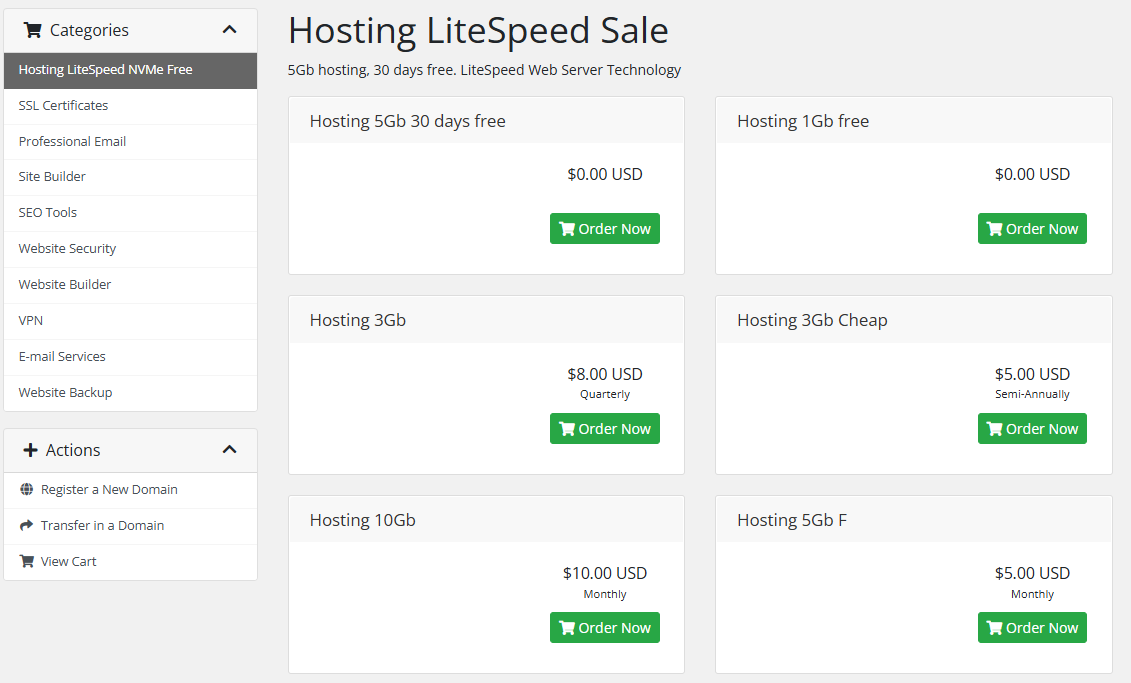Classic free website hosting offers (available in 2025)
These hosting companies offer traditional/classic web hosting accounts that just happen to be free. In other words, you get access to a server and a user panel, plus you can install a website, customize its settings, and so on.
1. litespeed.top (high speed)
- Best for: PHP websites with MySQL databases
- Details:
- Using modern OpenLiteSpeed technology with the highest speed available today.OpenLiteSpeed combines speed, security, scalability, optimization and simplicity in one friendly open-source package.
- Free Storage up to 5gb.
- There are many versions of Php, Mariadb to choose from for each website.
- Cyberpanel has direct decompression and compression tool for free account.
- URL: https://litespeed.top
InfinityFree
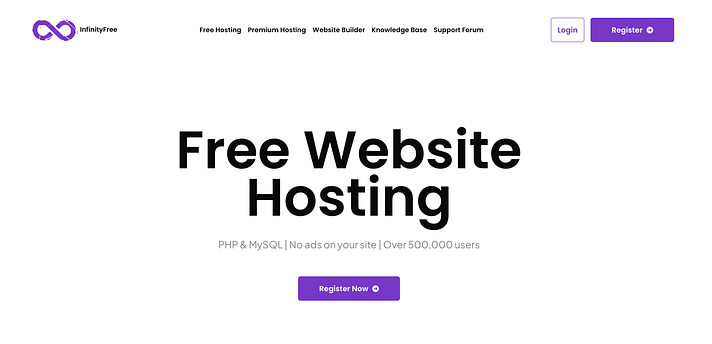
InfinityFree is a free website hosting service that promises to provide unlimited disk space and bandwidth. It supports the latest PHP and MySQL versions, offers free subdomains, and includes a free SSL certificate. Key features include no ads on your site, a simple control panel, and a Softaculous script installer – so that you can launch a site on WordPress, for example.
However, not all users might enjoy the experience. Some report that the backend is cluttered with ads and links to paid third-party tools. Issues like file managers not functioning properly and non-existent support can be problematic for everyday use, too.
InfinityFree can be ideal for hobbyists, students, and small projects. However, it may require patience and technical know-how to navigate the challenges it comes with, so you should be aware of those before launching any serious site using the platform.
Important details:
- 5 GB disk space
- Unlimited bandwidth
- You can bring your own domain
- Free SSL
- PHP 8.2
- MySQL 8.0 / MariaDB 10.6
- 400 MySQL databases
- Free DNS service
InfinityFree is powered by iFastNet, which also offers premium hosting. The cheapest plan starts at $5.99 a month and includes six free domains (interesting!), unlimited disk space, and more features.
Other free web hosts
Initially, I wanted to give you a larger list of recommendations of classic free hosting. However, it turns out that the company above is the only one with a good(ish) reputation and a good balance of positive reviews online. There was also 000webhost some time back, but that one got discontinued by its parent company – Hostinger.
For the rest of the free hosts, though, it’s a mixed bag really, and the reviews are much less positive.
However, I still want to give you a list of more options, but please do take them with a grain of salt. I’d still recommend testing out the two free hosts above first ☝️, and then going down the list only if you find yourself not liking something about the ones above.
With that disclaimer out of the way, here are some additional companies that also offer free hosting:
FreeHosting.com
Key features:
- 10 GB of disk space
- Unmetered bandwidth
- Host one website
- One email account included
- One MySQL database
- FTP account access
- Website builder tool available
Freehostia
Key features:
- 250 MB disk space
- 6 GB monthly traffic
- Five hosted domains
- Three email accounts
- One MySQL database
- Free site builder
- One-click app installer
Free Web Hosting Area
Key features:
- 1.5 GB disk space
- Unmetered bandwidth
- Free subdomains
- FTP account access
- MySQL database
- PHP support
- Daily backups
AwardSpace
Key features:
- 1 GB disk space
- 5 GB monthly traffic
- One email account
- Three free subdomains
- MySQL database
- PHP support
- One-click CMS installer
ByetHost
Key features:
- 1 GB disk space
- 50 GB monthly transfer
- Five subdomains
- VistaPanel control panel
- Five MySQL databases
- PHP support
- Softaculous script installer
ForeverFreeHost.com
Key features:
- 10 GB disk space
- Unlimited bandwidth
- Free subdomains
- Free SSL certificates
- PHP and MySQL support
- No ads on your site
- Free DNS service
- Email accounts
All-in-one website platforms with free plans
For this part of the list, we’re moving away from the traditional web hosts and focusing more on the top all-in-one solutions that let you build a website and then make it public for the world to see all in one place.
The specific platforms that I’m listing here below also offer free plans.
In other words, you can host your website for free with these platforms, but only as long as you’re also going to build your website using that platform.
Wix

Wix is one of the most popular website platforms on the web (it’s either Wix or Squarespace as top 1 and 2), and the top such solution that comes with a free plan. It can be ideal for beginners or those on a tight budget.
This free plan allows you to create and launch a basic website without any financial commitment, plus you get to use Wix’s tools and ready-made designs to do so. Wix is an all-in-one tool, meaning that all you need to do to get started is visit Wix.com, sign up (no credit card is required), and then follow the guided steps.
Wix provides over 800 themes to choose from. Though an important thing to know is that while you can customize various design elements, switching the main theme after launch can be challenging. The Wix pane is also pretty crowded, which can slow you down a bit if you just want to launch a free website quickly.
The free plan gives you a website address based on a subdomain, which isn’t very attractive (accountname.wixsite.com/sitename). It also places ads on every page, offers up to 500 MB of storage and 1 GB of bandwidth. Free users have limited customer support, and there’s no possibility to collect payments or use Google Analytics on the free plan.
Wix’s free plan can still be perfect for new websites and users who value quick setup above everything else. Plus, if you ever want to expand – add an ecommerce store or other advanced features – then you can always upgrade to one of Wix’s paid plans, which start at $17.00 / month.
Weebly

Weebly is a versatile website builder overall and a strong alternative to Wix when it comes to the features offered and the free plan limitations. For example, you’re allowed to showcase portfolios and sell products on the free plan (though there are transaction fees). On the other hand, though, you can only have up to five pages on your free website.
If you find the Wix interface a bit too confusing or dislike Wix’s ad in the top bar of your site, Weebly might be a better fit for you. The platform features a user-friendly drag-and-drop interface, making it easy for beginners to create and customize their websites.
Weebly also comes with a variety of design options and customizations, allowing you to choose from a wide range of modern themes that can be tailored to your specific needs. You can further enhance your site’s appearance with features such as photo galleries, slideshows, social media icons, newsletter subscription boxes, built-in analytics, and more.
The free plan allows you to host your blog under a SITE.weebly.com subdomain. Before making your blog public, you need to verify your user information. Overall, Weebly offers a comprehensive and user-friendly solution for anyone looking to start a blog, showcase their portfolio, or even sell products online without incurring initial costs. Then, of course, if you ever need more, the paid tiers start at $12.00 / month.
Jimdo

Jimdo is another user-friendly website builder – similar to Wix – that offers a free plan for creating and hosting websites. It provides 500 MB of storage and 2 GB of bandwidth, which should be suitable for small websites and personal projects. Free websites are hosted under a SITE.jimdosite.com subdomain, giving you a semi-professional-looking web address – at least better than Wix’s.
The platform features modern templates with basic customization options. Jimdo includes essential features such as contact forms, social media integration, and basic SEO tools to help optimize your site for search engines. The intuitive drag-and-drop interface makes it easy for beginners and those with limited technical skills to create and manage their websites.
Strikingly
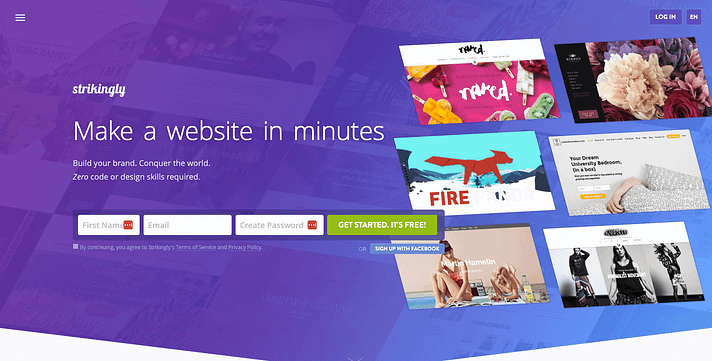
Strikingly offers a free plan designed for users who want to create multiple websites without any upfront costs (this is quite unique compared to the other options above). With the free plan, you can build unlimited free sites, each hosted under a SITE.strikingly.com subdomain. This plan provides 5 GB of monthly bandwidth and 500 MB of total storage per site.
Each site can have up to five pages, which is not a lot but can still be enough for a small experimental project. Additionally, the free plan includes a simple store feature, enabling you to sell one product per site. This is a great option for those looking to dip their toes into ecommerce without a financial commitment.
Strikingly’s free plan also allows you to invite collaborators, plus you have access to 24/7 support, ensuring that help is available whenever you need it.
Overall, Strikingly’s free plan is ideal for individuals and small businesses seeking a straightforward and cost-effective way to establish an online presence, with the flexibility to create multiple sites and the support to help you succeed.
Dev-friendly hosting that’s free
If you’re not afraid to get your hands dirty under the hood of a website, so to speak, then there are many more options available for you out there.
Particularly, it turns out that multiple platforms specializing in hosting web applications or providing computing infrastructure or cloud tools also offer free hosting that’s available publicly. The catch is, of course, that it’s not as simple as signing up with an email and building your site with drag and drop (like on Wix, for example).
You need to do a lot more legwork here, but it is well worth it. The results are awesome when it comes to the final performance and reliability of your site. They are not great, however, for ongoing site updates or figuring out stuff when anything goes wrong.
Let’s take these platforms one by one and explain how this works:
GitHub Pages + Jekyll
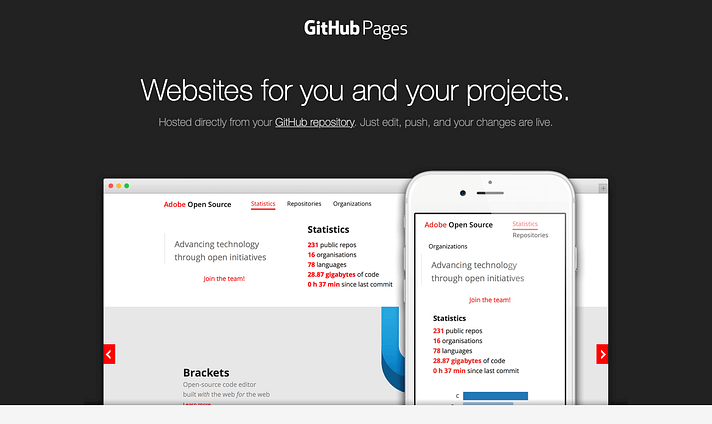
GitHub Pages is a free service offered by GitHub. It allows you to host static websites directly from a GitHub repository. If you’re fairly comfortable hosting websites the standard way – i.e., by uploading files to a server – then GitHub Pages provides a more streamlined alternative where everything is coordinated through the GitHub repo, along with version control to simplify the process of managing and updating your site.
This means you can easily track changes, collaborate with others, and even revert to previous versions of your site if needed. Instead of manually uploading files to a server, you simply push your changes to your GitHub repository, and GitHub Pages takes care of the rest, automatically updating your site. Of course, this is a great solution for more complex websites, perhaps, where there are multiple collaborators all working together at the same time on the same project.
That being said, however, you can also treat GitHub Pages in a more minimalistic manner and simply use it to deploy simple static websites. As in, there’s no direct way to add any dynamic server-side processing like PHP or databases, but you can still work around it.
Namely, you can use another layer provided by a tool called Jekyll. It is a static site generator that lets you build sophisticated sites using simple text files and templates.
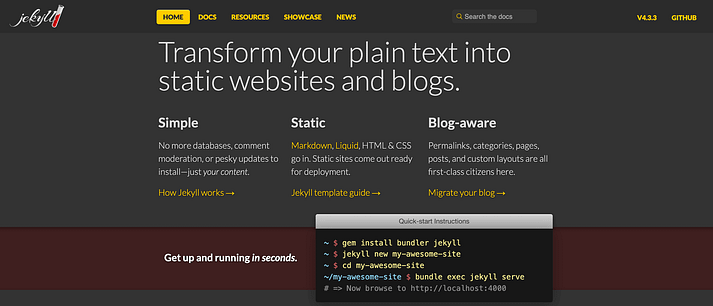
Additionally, you can also hook up the whole thing to a custom domain name, which makes it appear like a fully-fledged site instead of something that’s being hosted for free.
The process of setting everything up involves a couple of steps, and things can get a bit technical. In short; you’ll have to: (1) set up GitHub Pages by creating a GitHub repository; (2) install Jekyll on your local machine; (3) create a project locally by picking a theme, customizing it, adding content to the site, etc.; and (4) push your Jekyll site to the GitHub Pages repository.
Once your site is pushed to GitHub Pages, it will be publicly accessible under a URL based on your GitHub username. This setup doesn’t provide a traditional dashboard like other blogging platforms; instead, you manage content and make updates through Markdown files and Git version control.
While the setup process may seem complex initially, especially if you’re new to GitHub or command-line tools, the results are a highly customizable and performant static site. When it comes to site designs, you can find a number of options online on sites like jekyllthemes.io, jekyllthemes.org, and themes.jekyllrc.org.
In the end, hosting a Jekyll site on GitHub Pages is a powerful way to create a custom publication without recurring costs. However, it requires some technical know-how to get started and manage. Lastly, be mindful of the limitations of this free plan; specifically, the maximum size for a GitHub repository (including the history) is 1 GB, and GitHub Pages sites have a soft bandwidth limit of 100 GB / month and a limit of 100,000 requests / hour.
Cloudflare Pages
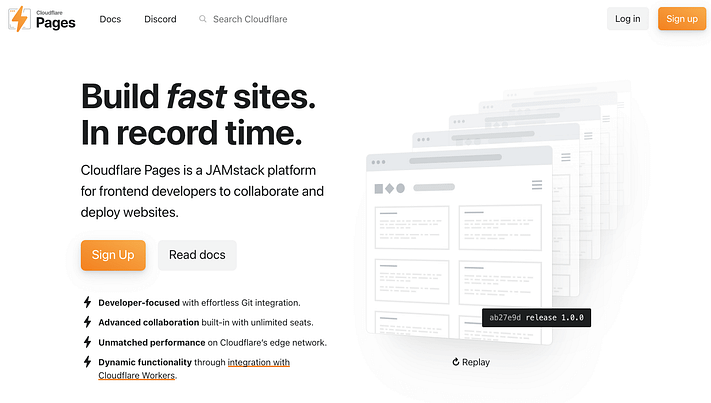
Cloudflare Pages is a solution that’s very similar to GitHub Pages – at least for the purpose for which we’re going to use it here. It’s a platform designed for hosting static websites, using Cloudflare’s own global network for fast, secure, and reliable delivery. It also integrates with Git repositories, in case you want to ensure continuous deployment and somewhat easier updates. A key perk when it comes to Cloudflare Pages, though, is that it provides this website hosting entirely for free.
Now, technically, you can host the same static site both with GitHub Pages and Cloudflare Pages, but there are some differences in how the final site operates:
- GitHub Pages has limitations on custom plugins and build processes, often requiring users to build sites locally for custom configurations. Cloudflare Pages, however, allows for custom build commands and environment variables, supporting modern development workflows and preview deployments.
- Performance-wise, GitHub Pages serves sites through GitHub’s infrastructure, which, while reliable, may not be as globally distributed as a dedicated CDN. Cloudflare Pages leverages Cloudflare’s own extensive global CDN, ensuring faster load times by serving content from servers closest to the visitor.
Overall, Cloudflare Pages offers more flexibility, enhanced performance through its CDN, and a robust set of features for advanced configurations and security options.
On the other hand, if you just want to launch a simple static site on Cloudflare Pages, then the process can be pretty simple. Plus, you can use a local installation of WordPress to be your donor site. What you can do is: (1) create your WP site locally and then turn it static, (2) ZIP your site, (3) sign up to Cloudflare and go to the Workers and Pages menu, (4) upload your website and deploy it.
This is literally it. Cloudflare will make your site available under SITE-NAME.pages.dev. Of course, you can also hook up a custom domain name.
If you’re interested, here’s a full video tutorial on how to get a static WordPress site deployed to Cloudflare Pages from start to finish:
More alternatives for hosting free static sites that work similarly to Cloudflare Pages
The platforms below might have some differences as to the specific parameters or steps of how to set a free static website with them. However, the main underlying idea is still the same – as in, you’ll have to build a static website first, and then you can roll it out to be hosted for free.
In other words, they’re excellent Cloudflare Pages alternatives:
Vercel

Key features:
- One concurrent build, 100 GB / month bandwidth, HTTPS/SSL by default, DDoS mitigation
- All features and plans
Netlify

Key features:
- 1 free member, with free and unlimited Git Contributors, one concurrent build, 100 GB / month bandwidth, 500 websites, 300 build minutes
- All features and plans
Both of these platforms have tons of features and they openly list every little parameter that might be of importance to a developer. Check out the official pages to get all the info you need (both linked above).
Creative methods to host a site for free
This is the most mysteriously sounding category of the ones I want to cover here, but it’s also perhaps the most fun! I was really amazed when I discovered some of these methods and all the possibilities they open, but at the same time, you’ll need to keep an open mind since many of them are not what you’d call “a traditional website.” In other words, they will let you host “very specific kinds of websites” for free.
Notion
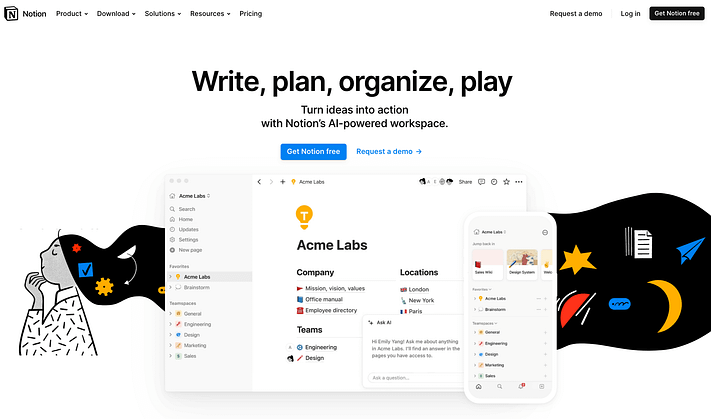
Notion is a very popular tool nowadays, though it’s not that known for its website abilities. In short, it’s an all-in-one workspace that combines note-taking, task management, database creation, and collaboration tools. It was designed to help individuals and teams organize their work and streamline their productivity.
For personal use, it can help you manage your tasks, plan projects, and organize daily life with features like to-do lists and calendars. In team settings, it’s quite useful for project management and collaboration. Students and educators benefit from Notion by organizing study materials, taking notes, and managing schedules. There are also some great implementations of Notion as a CRM, a company wiki, and loads of other uses.
Then, among those more original use cases, Notion can also serve as your website platform and free hosting all in one place.
Natively in Notion, you can take any page and make it public on the web. Granted, this is only a single page (not a whole site yet). You can also choose whether your page should be visible on Google or not, which is a key feature for most real websites. The best part is that you don’t have to settle for single-page hosting. There’s a very active community around Notion, with loads of third-party tools that make Notion much more powerful.
For example, platforms like Super.so or Potion.so allow you to portion off a section of your Notion workspace and have it published to the web as a standalone website. Basically, you can create a hub in Notion, add individual pages, link it all through some menus and normal links, and then have it deployed to the web as a whole standalone website. And, as you would expect at this point, both Super and Potion come with free plans. Check it out.
Substack

Substack is most known for being a newsletter platform. As in, it’s where authors can share their content, and readers can subscribe to get that content delivered to their inboxes. However, Substack can also function effectively as a website engine, along with free hosting. This dual capability makes it an excellent choice for writers looking to establish an online presence without technical hassle.
The platform is designed for simplicity, making it accessible even for those who aren’t tech-savvy. The interface is straightforward, with a clear navigation menu and easy-to-find content publication options.
As a website, Substack supports text, images, videos, code blocks, LaTeX for technical writing, and polls. Recently, Substack has added features like micro-blogging with “Notes,” podcasting options, and a chat feature for real-time conversations with readers.
I’m saying all this here to highlight that for the right kind of user, opting for a free Substack “site + newsletter” combo might be all they’ll ever need.
Even monetizing a Substack is possible. The platform includes features like “pledges” to gauge your audience’s willingness to pay for your content.
Of course, however, there are some limitations on what you can do with a website like that. Most notably, the design options are minimal, focusing on functionality over aesthetic flexibility. URLs follow a standard structure, and while you can use a custom domain, it requires a one-time fee.
Overall, Substack is ideal for writers who want to focus on content creation without worrying about web design. It offers a robust set of tools to grow and monetize your audience, all for free or with minimal costs, making it a powerful platform for both newsletters and websites.

